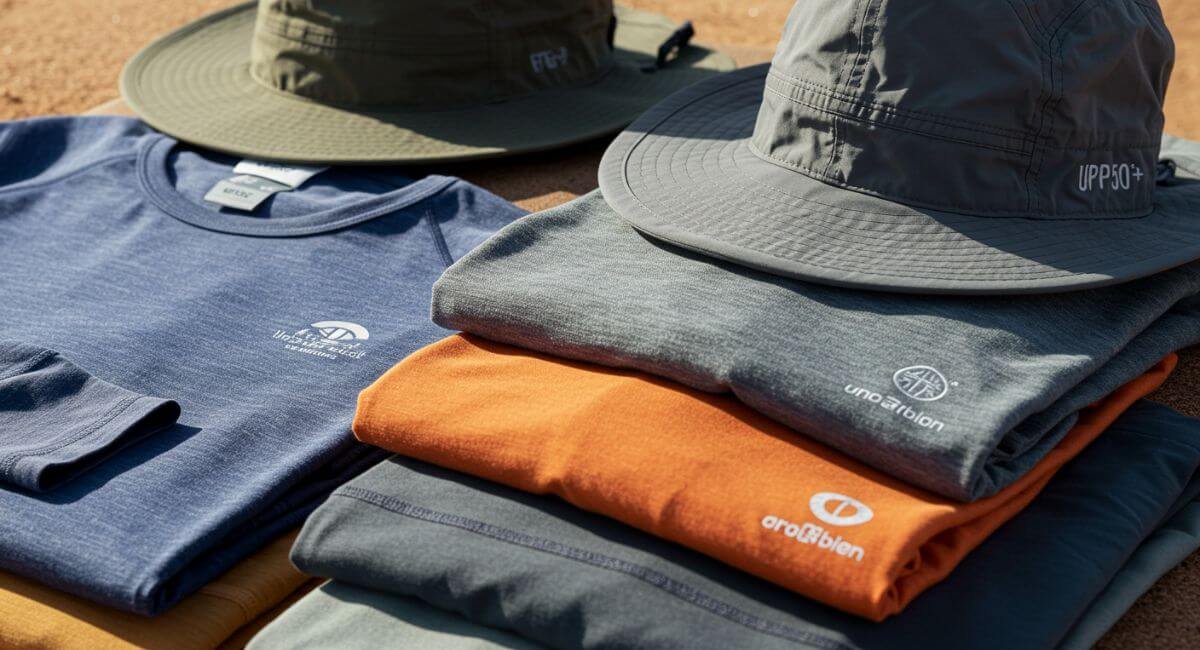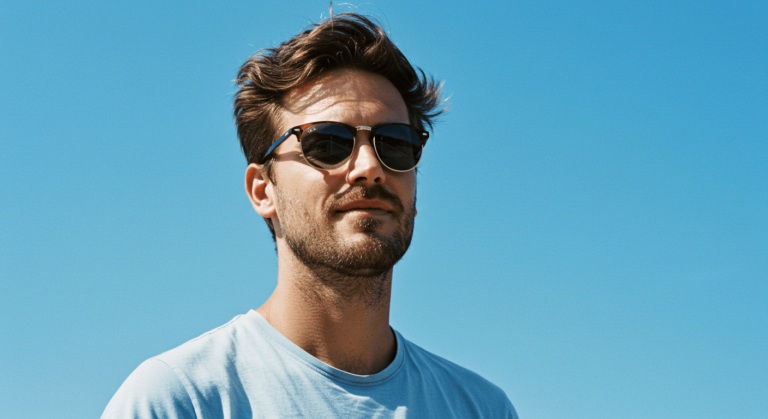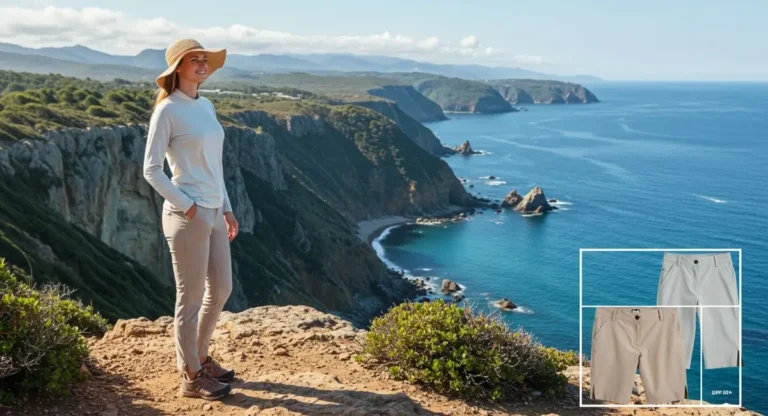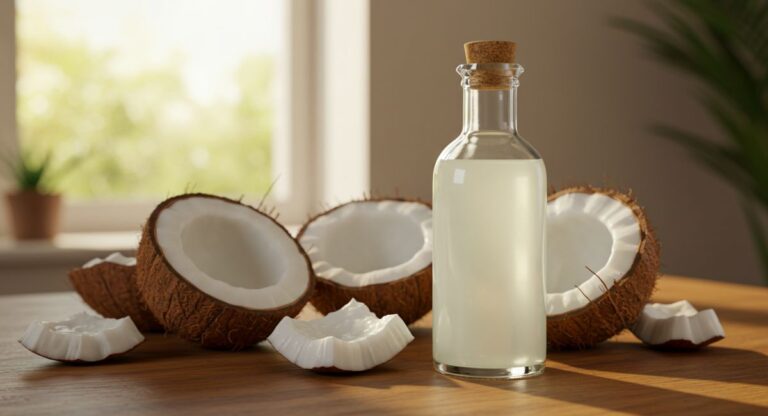Best Sun Protective Clothing for Beach Days, Hikes & Everything In Between
Why Your Skin Deserves Better Than Just Sunscreen
Remember that painful sunburn from your last beach vacation? The one that turned your relaxing getaway into days of wincing every time fabric touched your skin? I certainly do. Despite liberally applying sunscreen, I learned the hard way that sometimes, it’s just not enough.
You’re diligent about sun protection—you’ve got the SPF 50, you reapply every two hours, you seek shade during peak hours. But what if there was a more effective way to shield your skin from harmful UV rays without the constant hassle of reapplication? Enter sun protective clothing—your skin’s new best friend and the missing piece in your comprehensive sun protection strategy.
In this guide, you’ll discover everything you need to know about sun protective clothing, from understanding UPF ratings to selecting the perfect pieces for different activities. Whether you’re planning a beach vacation, a mountain hike, or simply want better everyday protection, this article will help you make informed choices that keep your skin safe and healthy for years to come.
Understanding Sun Protection Basics
Before diving into specific clothing recommendations, it’s important to understand what you’re protecting yourself against and why.
The Science of Sun Damage
The sun emits ultraviolet (UV) radiation in three forms:
- UVA rays: Penetrate deeply into the skin, causing premature aging and contributing to skin cancer
- UVB rays: Primarily responsible for sunburns and play a key role in developing skin cancer
- UVC rays: Mostly absorbed by the Earth’s atmosphere and don’t typically reach your skin
When you’re outdoors, your skin is exposed to both UVA and UVB rays, which can cause immediate damage (sunburn) and long-term effects (premature aging, skin cancer). According to the Skin Cancer Foundation, more people are diagnosed with skin cancer each year in the U.S. than all other cancers combined, with one in five Americans developing skin cancer by age 70.
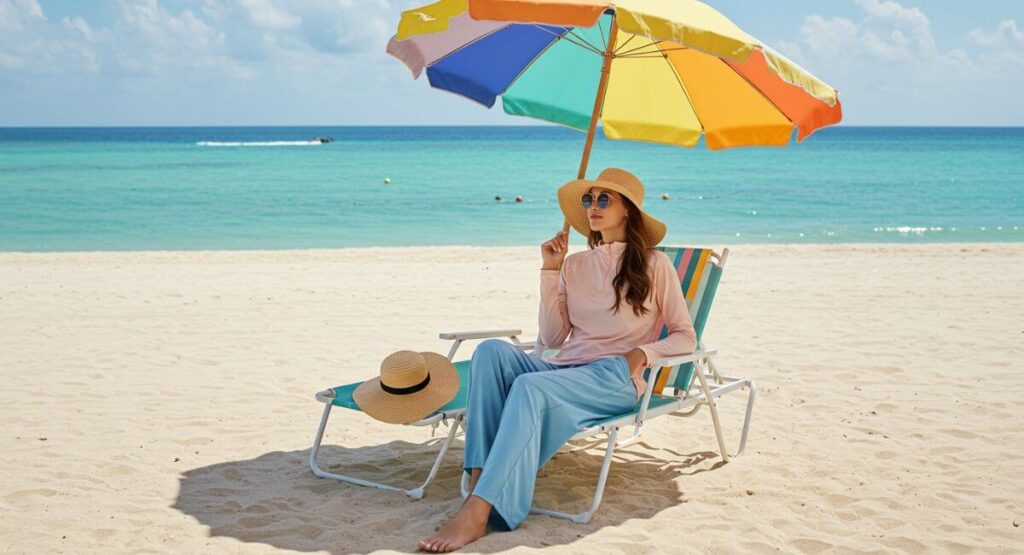
SPF vs. UPF: What’s the Difference?
You’re likely familiar with SPF (Sun Protection Factor), which measures how effectively a sunscreen protects against UVB rays. However, when it comes to sun protective clothing, the relevant measure is UPF (Ultraviolet Protection Factor).
UPF ratings indicate how much UV radiation a fabric blocks:
| UPF Rating | Protection Level | % UV Blocked |
|---|---|---|
| UPF 15-24 | Good | 93.3-95.9% |
| UPF 25-39 | Very Good | 96.0-97.4% |
| UPF 40-50+ | Excellent | 97.5-98%+ |
A garment with UPF 50 allows only 1/50th (or 2%) of UV radiation to pass through to your skin, blocking 98% of the sun’s rays. For comparison, a typical white cotton t-shirt offers only about UPF 5, allowing 20% of UV rays to reach your skin.
What Makes Clothing Sun Protective?
Not all clothing is created equal when it comes to sun protection. Several factors influence how effectively a garment shields you from harmful rays:
Fabric Composition
The type of material significantly impacts UV protection:
- Synthetic fibers like polyester and nylon typically offer better protection than natural fibers
- Tightly woven fabrics provide more protection than loose weaves
- Darker colors generally absorb more UV radiation than lighter shades
- Special treatments with UV-absorbing chemicals enhance protection
Construction Features
Beyond the fabric itself, certain design elements increase protection:
- Collars that can be flipped up to protect the neck
- Long sleeves with thumbholes to cover the backs of hands
- Wide brims on hats to shade the face, ears, and neck
- Vents and mesh panels for breathability without compromising protection
UPF Certification
Reputable sun protective clothing brands have their garments laboratory-tested to determine their UPF rating. This testing measures how much UV radiation passes through the fabric under various conditions, including when the fabric is wet or stretched.
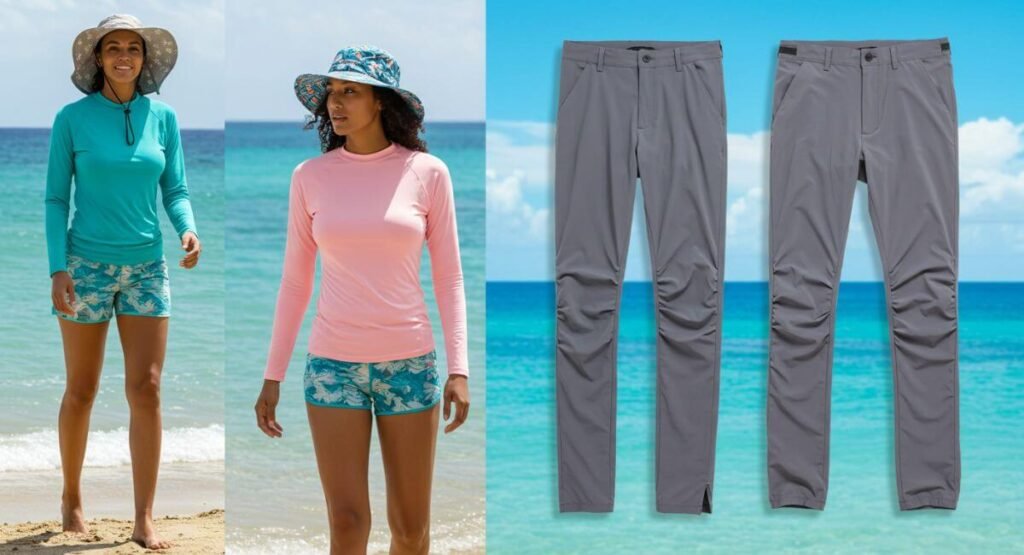
Essential Sun Protective Clothing Pieces for Every Activity
Different outdoor activities call for specific types of sun protection. Let’s break down the essential pieces you need for various scenarios.
Beach and Water Activities
Beach days expose you to intense sun from both direct sunlight and reflections off water and sand, which can increase UV exposure by up to 25%.
Must-Have Items:
- UPF 50+ Rash Guards Rash guards provide excellent coverage for upper body protection while swimming or surfing. Look for styles with high necks and long sleeves for maximum protection. The UV Skinz swimsuit collection offers stylish rash guards for the whole family with UPF 50+ protection that doesn’t wash out over time.
- Sun Protective Swim Leggings Protect your legs with UPF-rated swim leggings that stay comfortable in and out of the water.
- Wide-Brimmed Sun Hats A good sun hat is essential for beach days. Coolibar hats feature wide brims (3+ inches) that provide 360-degree protection for your face, ears, and neck. Their breathable, packable designs make them perfect beach companions.
- Beach Cover-Ups When you’re not in the water, a lightweight UPF cover-up provides additional protection while keeping you cool.
Pro Tip:
“For extended time in the water, combine a UV Skinz swimsuit with a rash guard for maximum protection. Their fabrics are chlorine and saltwater resistant, ensuring lasting UPF protection trip after trip.”
Hiking and Outdoor Adventures
Hiking exposes you to intense sun, especially at higher elevations where UV radiation increases by about 4-5% for every 1,000 feet above sea level.
Must-Have Items:
- UPF 50+ Long-Sleeve Shirts Lightweight, breathable shirts with UPF protection are essential for hiking. Look for:
- Moisture-wicking fabrics
- Ventilation features
- Roll-up sleeve options for temperature regulation
- Sun Protective HatsSolbari hats are excellent choices for hiking, with their:
- Wide, stiff brims that maintain shape in windy conditions
- Neck capes for additional protection
- Moisture-wicking sweatbands
- Chin straps to keep the hat secure during activities
- Hiking Pants or Convertible Pants UPF-rated pants protect your legs from both sun and trail obstacles.
- Sun Sleeves and Neck Gaiters These accessories provide additional protection for exposed areas and can be added or removed as needed.
Pro Tip:
“Layer your sun protection for hiking. Start with a moisture-wicking base layer, add a Solbari hat for head and neck coverage, and keep sun sleeves in your pack for when the sun intensity increases.”

Everyday Protection
Sun protection isn’t just for special outdoor activities—it’s important for everyday life too.
Must-Have Items:
- Casual UPF Button-Down Shirts These versatile pieces work for both casual and business casual settings while providing excellent sun protection.
- Sun Protective Cardigans Lightweight UPF cardigans are perfect for throwing over outfits when you’ll be moving between indoor and outdoor environments.
- Everyday Sun HatsCoolibar hats come in everyday styles that provide protection without looking overly technical:
- Fedora styles
- Bucket hats
- Crushable wide brims that bounce back after packing
- UPF Driving Gloves Protect your hands from sun exposure through car windows, which typically block UVB but not UVA rays.
Top Brands in Sun Protective Clothing
When investing in sun protective clothing, quality matters. These leading brands consistently deliver reliable UPF protection:
Coolibar
Founded by an Australian with first-hand experience of the harsh sun, Coolibar has been at the forefront of sun protective clothing since 2001. Their extensive collection includes:
- Coolibar hats ranging from active styles to fashion-forward designs
- Innovative fabrics engineered specifically for sun protection
- Clothing options for all ages and activities
- Third-party testing to verify UPF claims
What sets them apart: Coolibar uses proprietary fabric technologies like ZnO SUNTECT®, which incorporates zinc oxide (the same active ingredient in many mineral sunscreens) directly into their fabrics.
UV Skinz
This brand was founded by a mother who lost her husband to melanoma, giving them a passionate commitment to sun protection. Their standout products include:
- UV Skinz swimsuits with UPF 50+ protection
- Comfortable, stylish designs for the entire family
- Chlorine and saltwater resistant materials
- Sustainable manufacturing practices
What sets them apart: UV Skinz offers an annual free baby sun shirt program to promote early sun protection habits.
Solbari
Born in Australia, where skin cancer rates are among the world’s highest, Solbari focuses on combining fashion with serious sun protection:
- Solbari hats with elegant designs and structural integrity
- Medical-grade sun protection (UPF 50+)
- Endorsed by cancer councils
- Premium fabric quality
What sets them apart: Solbari’s products are recommended by dermatologists and have received recognition from skin cancer foundations worldwide.
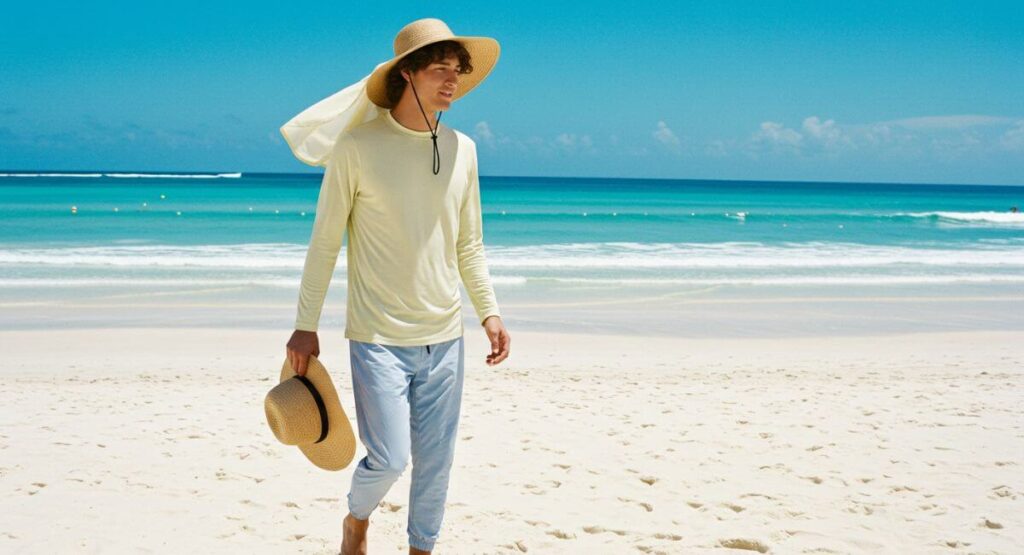
How to Choose the Right Sun Protective Clothing
With so many options available, how do you select the pieces that will work best for you? Consider these factors:
Activity-Specific Features
Match your clothing to your planned activities:
- For water sports: Quick-drying fabrics, secure fits, and strategic seam placement to prevent chafing
- For hiking: Breathability, range of motion, and convertible features
- For everyday wear: Style considerations alongside protection
Climate Considerations
Different climates require different approaches:
- Hot, humid environments: Look for moisture-wicking, lightweight fabrics with ventilation features
- Cool or variable weather: Consider layering options with different weights of UPF clothing
- Windy conditions: Choose hats with secure chin straps like those found on Solbari hats
Fit and Comfort
The best sun protective clothing is the clothing you’ll actually wear:
- Ensure proper fit—too tight and the fabric may stretch, reducing UPF; too loose and it may gap, allowing sun exposure
- Try before buying when possible, or check sizing charts carefully
- Consider how the garment feels against your skin, especially for activities where you’ll be moving a lot
Hat Selection Guide
Hats are perhaps the most important sun protective accessory. When choosing between brands like Coolibar hats and Solbari hats, consider:
Face Shape Matching:
| Face Shape | Recommended Hat Styles |
|---|---|
| Round | Fedoras, structured brims |
| Oval | Most styles work well |
| Square | Rounded crowns, soft brims |
| Heart | Medium brims, bucket styles |
| Long | Wide brims, high crowns |
Activity Matching:
| Activity | Hat Features to Look For |
|---|---|
| Beach | Packable, washable, floating |
| Hiking | Secure fit, neck cape, ventilation |
| Gardening | 360° protection, washable |
| Travel | Crushable, versatile styling |
| Everyday | Fashion-forward designs, color options |
Styling Your Sun Protective Clothing
Protection doesn’t have to compromise style. Here’s how to make sun protective clothing work with your personal aesthetic:
Beach Style
- Layer a colorful UV Skinz swimsuit under a complementary rash guard
- Add a wide-brimmed Coolibar hat in a coordinating color
- Complete the look with UPF sarongs or cover-ups for beachside dining
Active Outdoor Style
- Choose technical pieces in matching color schemes
- Accessorize with sporty Solbari hats that complement your outfit
- Add polarized sunglasses and UPF neck gaiters for a cohesive look
Everyday Elegance
- Select sun protective pieces that mimic current fashion trends
- Layer UPF cardigans over regular clothing
- Choose Coolibar hats with fashion-forward designs that enhance your outfit
Mix and Match Strategy
You don’t need an entirely UPF wardrobe. Strategic pieces can dramatically increase your protection:
- Start with high-quality UPF hats, like Coolibar hats or Solbari hats
- Add UPF tops and cardigans that coordinate with your existing wardrobe
- Gradually replace high-exposure items (swimwear, outdoor activity clothing) with options like UV Skinz swimsuits
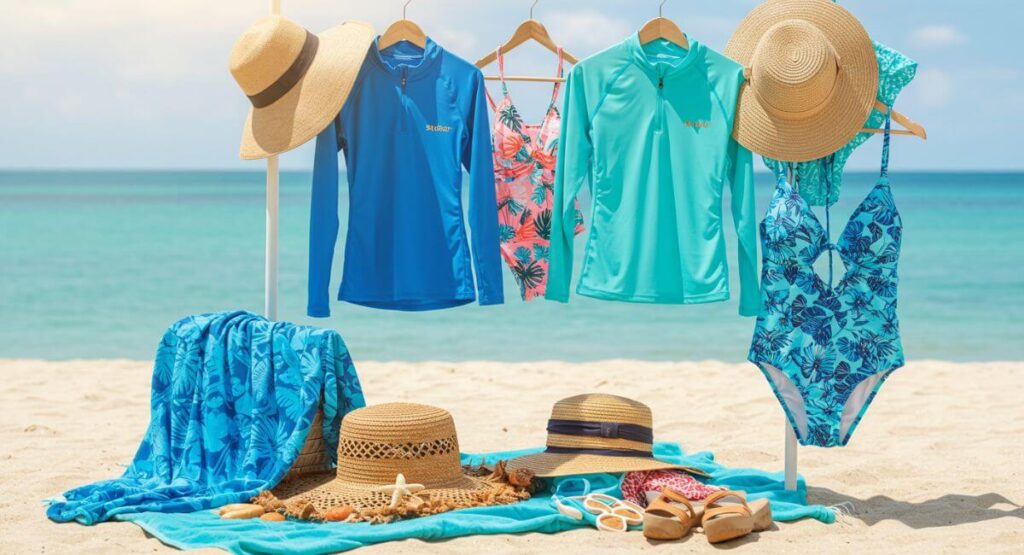
Caring for Your Sun Protective Garments
Proper care ensures your sun protective clothing maintains its UPF rating over time:
Washing Guidelines
- Follow manufacturer instructions closely
- Use mild detergents free of brighteners or bleach
- Consider specialized detergents designed for technical fabrics
- Wash garments inside out to protect the outer surface
Drying and Storage
- Air drying is typically best for maintaining UPF properties
- If using a dryer, use low heat settings
- Store items away from direct sunlight when not in use
- Hang structured hats like Solbari hats on dedicated hooks to maintain shape
Lifespan Assessment
- Check for signs that UPF effectiveness may be compromised:
- Visible stretching or thinning of fabric
- Significant fading
- Worn areas or holes
- Replace critical items like UV Skinz swimsuits regularly if you use them frequently
Key Takeaways
- Sun protective clothing provides consistent protection without the need for reapplication like sunscreen
- UPF ratings of 40+ or 50+ offer excellent protection, blocking 97.5-98% of harmful UV rays
- Activity-specific clothing enhances both protection and comfort—consider UV Skinz swimsuits for water activities and Coolibar hats for versatile protection
- Quality matters when it comes to sun protection—invest in reputable brands with verified UPF ratings
- Proper care extends the life and effectiveness of your sun protective garments
- Sun protection should be year-round, not just during summer months or beach vacations
- Layering UPF clothing with sunscreen provides the most comprehensive protection
FAQs About Sun Protective Clothing
Does all clothing provide sun protection?
While all clothing provides some barrier against UV rays, standard clothing typically offers minimal protection. A regular white t-shirt may have a UPF of only 5-7, meaning it allows 15-20% of UV rays to reach your skin. Dedicated sun protective clothing with UPF 50+ ratings blocks 98% or more of harmful rays.
Can I make my regular clothing more sun protective?
Yes, some laundry additives can increase the UPF rating of regular clothing. Products like SunGuard add UV-absorbing chemicals to your clothes during the wash cycle, potentially increasing protection to UPF 30 for about 20 washes. However, purpose-made UPF clothing like Coolibar hats or UV Skinz swimsuits is still more reliable.
Is sun protective clothing hot to wear?
Modern sun protective clothing is designed to be comfortable even in hot weather. Many UPF fabrics feature moisture-wicking technology, ventilation, and lightweight constructions specifically engineered for comfort in the heat. Brands like Coolibar and Solbari have developed proprietary fabrics that are both protective and breathable.
Do UPF clothes lose protection when wet?
Quality sun protective clothing maintains most of its protection when wet. UV Skinz swimsuits, for example, are specifically designed to maintain their UPF 50+ rating in water. However, some lower-quality items may offer reduced protection when wet, stretched, or worn out.
How does sun protective clothing compare to sunscreen?
Sun protective clothing offers several advantages over sunscreen:
- No need to reapply every two hours
- No missed spots or uneven application
- No chemicals absorbed into the skin
- Cost-effective over time
- No waiting period before sun exposure
For comprehensive protection, experts recommend combining UPF clothing (especially Coolibar hats for head protection) with sunscreen on exposed areas.
Is sun protective clothing worth the investment?
Considering the long-term health benefits and the cost of quality sunscreen over time, sun protective clothing is typically a good investment. A single Solbari hat or UV Skinz swimsuit can last multiple seasons with proper care, providing consistent protection without ongoing sunscreen expenses for those covered areas.
Can children wear sun protective clothing?
Absolutely! Children’s skin is particularly vulnerable to sun damage, and UPF clothing provides excellent protection. Many brands, including UV Skinz, Coolibar, and Solbari, offer extensive children’s lines specifically designed for comfort and protection during active play.
Sun protection isn’t just a summer concern or exclusively for beach days—it’s a year-round health essential. By incorporating quality sun protective clothing into your wardrobe, you’re making a long-term investment in your skin’s health and appearance.
Whether you’re selecting Coolibar hats for everyday protection, UV Skinz swimsuits for water activities, or Solbari hats for outdoor adventures, the right UPF clothing can dramatically reduce your UV exposure while keeping you comfortable and stylish.
Remember, the best sun protection strategy is comprehensive: combine UPF clothing with sunscreen on exposed areas, seek shade during peak hours, and be mindful of reflective surfaces that can increase UV exposure. Your skin will thank you for decades to come!
Have you incorporated sun protective clothing into your wardrobe? Which pieces have become your must-haves? Share your experiences in the comments below!

